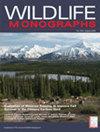Demographic data show many populations of Rocky Mountain (Cervus elaphus nelsoni) and Roosevelt (Cervus elaphus roosevelti) elk have been declining over the last few decades. Recent work suggests that forage quality and associated animal nutritional condition, particularly in late summer and early autumn, influence reproduction and survival in elk. Therefore, we estimated seasonal nutritional condition of 861 female elk in 2,114 capture events from 21 herds in Washington, Oregon, Wyoming, Colorado, and South Dakota from 1998 to 2007. We estimated ingesta-free body fat and body mass, and determined age, pregnancy status, and lactation status. We obtained estimates for most herds in both late winter–early spring (late Feb–early Apr) and in autumn (Nov–early Dec) to identify changes in nutritional condition of individuals across seasons.
Body fat levels of lactating females in autumn were consistently lower than their non-lactating counterparts, and herd averages of lactating elk ranged from 5.5% to 12.4%. These levels were 30–75% of those documented for captive lactating elk fed high-quality diets during summer and autumn. Body fat levels were generally lowest in the coastal and inland northwest regions and highest along the west-slope of the northern Cascades. Adult females in most herds lost an average of 30.7 kg (range: 5–62 kg), or about 13% (range: 2.6–25%) of their autumn mass during winter, indicating nutritional deficiencies. However, we found no significant relationships between spring body fat or change in body fat over winter with winter weather, region, or herd, despite markedly different winter weather among herds and regions. Instead, body fat levels in spring were primarily a function of fat levels the previous autumn. Thinner females in autumn lost less body fat and body mass over winter than did fatter females, a compensatory response, but still ended the season with less body fat than the fatter elk.
Body fat levels of lactating females in autumn varied among herds but were unrelated to their body fat levels the previous spring. Within herds, thinner females exhibited a compensatory response during summer and accrued more fat than their fatter counterparts over summer, resulting in similar body fat levels among lactating elk in autumn despite considerable differences in their fat levels the previous spring. Level of body fat achieved by lactating females in autumn varied 2-fold among herds, undoubtedly because of differences in summer nutrition. Thus, summer nutrition set limits to rates of body fat accrual of lactating females that in turn limited body condition across the annual cycle.
Pregnancy rates of 2- to 14-year-old females ranged from 68% to 100% in coastal populations of Washington, 69% to 98% in Cascade populations of Washington and Oregon, 84% to 94% in inland northwestern populations of Washington and Oregon, and 78% to 93% in Rocky Mountain populations. We found evidence of late breeding, even in herds with comparatively high pregnancy rates. Mean body mass of calves (n = 242) in 3 populations was 75 kg, 81 kg, and 97 kg, representing 55–70% of potential mass for 6- to 8-month-old calves on high-quality diets. Mean mass of 11 yearling females caught in autumn was 162 kg, approximately 70% of potential for autumn, and pregnancy rate was 27%. Mean mass of 28 yearlings caught in spring was 163 kg and pregnancy rate was 34%.
Our data suggest widespread occurrence of inadequate summer nutrition. Summer ranges of just 3 herds supported relatively high levels of autumn body fat (11–13% body fat) and pregnancy rates (>90%) even among females that successfully raised a calf year after year. Most other summer ranges supported relatively low autumn levels of body fat (5–9% body fat), and reproductive pauses were common (<80% pregnancy rates). Overall, our data failed to support 2 common assumptions: 1) summer and early autumn foraging conditions are typically satisfactory to prevent nutritional limitations to adult fat accretion, pregnancy rates, and calf and yearling growth; and 2) winter nutrition and winter weather are the principal limiting effects on elk productivity. Instead, a strong interaction existed among level of summer nutrition, lactation status, and probability of breeding that was little affected by winter conditions—adequacy of summer nutrition dictated reproductive performance of female elk and growth as well as growth and development of their offspring in the Northwest and Rocky Mountains. Our work signals the need for greater emphasis on summer habitats in land management planning on behalf of elk. © 2013 The Wildlife Society.


